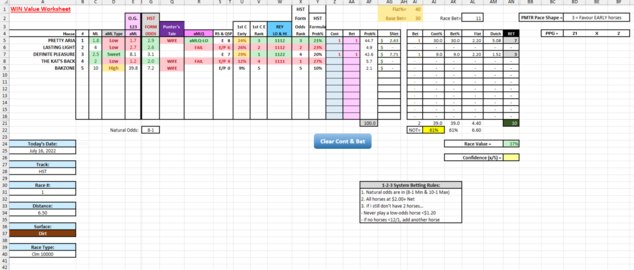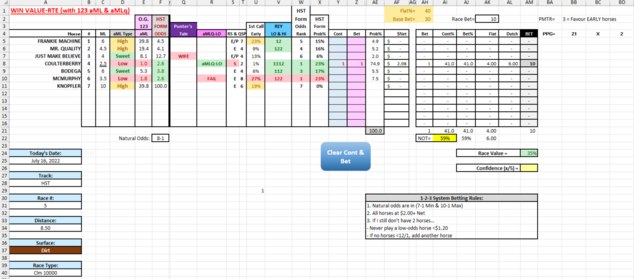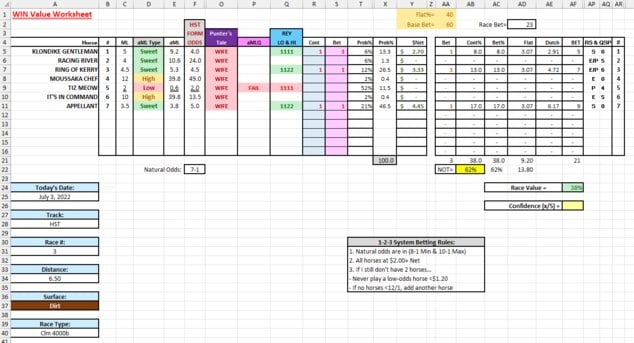Comments
-
Tom's Ulitmate Odds Line - The SoftwareMy results for HST on Sunday, 17 July 2022 are below. No chaotic black swan in the 6th, unfortunately.
Race 3:
- 2 - Smart Lad = (-$2)
- 4 - Stay Fantastic = (-$2)
- 7 - At Attention = +$6.80
Race 5:
- 3 - My College Fund = (-$2)
- 4 - Slew's Da Boss = (-$2)
- 5 - Parker Point = (-$3)
Race 6:
- 5 - Reprimand = (-$2)
- 6 - Klondike Gentleman = (-$2)
- 7 - Sword Fighter = (-$2)
- 8 - Martello = (-$2)
- 10 - It's In Command = (-$2)
- 11 - European = (-$2)
Overall, I'm down $16.20 for the day. So it goes. -
Tom's Ulitmate Odds Line - The SoftwareBelow you will find my selections for Hastings Racecourse on Sunday, 17 July 2022.
NOTE: The "% value" indicates how playable the race is according to my handicapping; the greater the value percentage, the larger amount of the pool belongs to my non-contenders. Here goes:
Race 1: 3% value = No Play
Race 2: 2% value = No Play
Race 3: 19% value = Marginal Plays
- 2 - Smart Lad = $2 to WIN
- 4 - Stay Fantastic = $2 to WIN
- 7 - At Attention = $2 to WIN
Race 4: 14% value = No Play
Race 5: 24% value
- 3 - My College Fund = $2 to WIN
- 4 - Slew's Da Boss = $2 to WIN
- 5 - Parker Point = $3 to WIN
Race 6: 49% value = CHAOS! I'm taking a big swing b/c the two low-odds horses are aMLq FAILURES. These horses will win on occasion - about 15-20% of the time - but my records indicate they're worth playing against in the long run.
- 5 - Reprimand = $2 to WIN
- 6 - Klondike Gentleman = $2 to WIN
- 7 - Sword Fighter = $2 to WIN
- 8 - Martello = $2 to WIN
- 10 - It's In Command = $2 to WIN
- 11 - European = $2 to WIN
Race 7: 14% value = No play -
Tom's Ulitmate Odds Line - The SoftwareMy results for HST 16 July 2022:
Race 1:
1 - Pretty Aria = 1st (+$21)
3 - Definite Pleasure = 5th (-$3)
Race 5:
4 - Coulterberry = 4th (-$10)
Race 7:
1 - Koala = 2nd (-$4)
4 - Lizzies Girl = 4th (-$2)
7 - Groovy Girl = 5th (-$2)
Looks like I'm even on the day - $21 in winnings (it was a strong start!) and $21 in losses. So it goes. -
Tom's Ulitmate Odds Line - The SoftwareWhile you guys are all playing Saratoga, I've got my eye on Hintofalimp at Podunk Downs over here in Vancouver, Canada...and here are my first public selections ever.
I've handicapped the card of 7 races for Hastings on Saturday, 16 July 2022. Here are my selections accompanied by screenshots of my Excel workbook for the three races that I found some value in:
HST 16 July 2022 - Race 1
1 - Pretty Aria = $7 to WIN
3 - Definite Pleasure = $3 to WIN

HST 16 July 2022 - Race 5
4 - Coulterberry = $10 to WIN

HST 16 July 2022 - Race 7
1 - Koala = $4 to WIN
4 - Lizzies Girl = $2 to WIN
7 - Groovy Girl = $2 to WIN

-
Tom's Ulitmate Odds Line - The SoftwareWell, I've been experiencing some ups and downs as I played around with my Tom's UOL-inspired Excel workbook to play Hastings. As it stood as of a couple of days ago, I'd built two WIN bet objects to play - one for sprints and one for routes. (It took me some time to build up a database of at least 20 route races because HST runs only 2 days a week with 7 races per card). I reckon that, seeing as it's a bullring, the differences between the sprints - run around two tight turns - and routes - run around 3 tight turns - would be significant enough that a specialized approach for each distance structure is warranted.
Once I created the objects (using the "How to Figure Out What Wins" method), I played around with them to see what might work for contender selection. Originally, I settled on a REYNOLDS 3 to choose my contenders. While that gave me only 3 or 4 contenders a race, it was tricky to discriminate between them and I was passing most races because I had too many contenders that constituted too much of the pool.
I am using the concepts from Roger LeBlanc's book, "The Punter's Tale", to find false favourites and toss out some low-priced horses. The concepts in the book are sound - false faves identified with his methods lose on a very regular basis - but they don't pop up in races that often. So, I put my thinking cap back on.
I reckoned that the good news is that my contender pool was very accurately chosen. I had 90% or so of the winners in my CONTs. Now, the fields at HST are small so this is no great shakes but...
Lightning struck when I was thinking about how to capitalize on my good contender selection. Two ideas came to mind:
1. Go one layer deeper with my Reynolds:. As per one of Dave's seminars, I decided to use my object to create REYNOLDS 4 numbers for low odds horses. This might help me toss some low odds duds.
2. Use the aMLq process from the 123 System seminar: This should point to low odds horses that are likely to fail and those non-qualifying low-odds horses can serve as play against types.
Well, lo and behold, now I'm finding more low odds horses to play against and this is allowing me to play more races because there's greater value in more of the races. I haven't tested this against live play yet - HST doesn't run again until Saturday - but I look forward to seeing if this revised approach will bear fruit.
Here's a screenshot so you can see what I'm up to. This image show my "WIN Value Worksheet" for sprints. I have another for routes.
Please note that, in the image, each of the contenders is noted as a "WIFE". This means that they meet the criteria for LeBlanc's "Mustachioed Wife" category. In this particular instance, it means that all of these horses have at least 2 losses at this distance structure and class level.
Back to the coal face to do some more refining of my workbook. I've created a PLACE bet object for both sprints and routes to help with exacta play. I want to see how those did over the past 2 days of racing.
Cheers,
Lawrence

-
Tom's Ulitmate Odds Line - The Software
I got the time decayed idea from how the RDSS (New Sartin Methodology folks at the Pace & Cap forum) compute their CSR - Composite Speed Rating... not to mention Benter. The CSR documentation is in the attached image. The CSR rating is powerful; my Hastings model shows that I can eliminate a contender that ranks 5th or higher in CSR. In terms of how I use the time decaying approach for class, I've time decayed (1) purse value, (2) odds in past races, and the (3) "race class" number - essentially the speed figure from the race winner - from Dave's "Sim Pace" Excel worksheet that was in the 123 System materials. I forget the exact combination and weight of factors in what I call my "Class TDx" object (I don't have my workbook on this computer).
The exact combination isn't really the point. What I see as important is that it's a way of considering class that:
- Other players don't use as it's unique to me
- Doesn't involve the earnings box (I got this idea from an HTR newsletter; they're chock full of amazing handicapping insight - and model-based statistics - from the mind of Ken Massa)
- Is proven to work based on the evidence of my model
It's this contrarian approach that seems to provide the edge. -
Tom's Ulitmate Odds Line - The SoftwareI will keep you posted.
I'm always tinkering, but my plan is to get it 90% complete and then post some selections - with an explanation - to give more insight into my process. -
Tom's Ulitmate Odds Line - The SoftwareUpdate on my Master Consensus project using Tom's Ultimate Odds Line and various other systems.
I was finding that I had so much information to sort through - I had info from essentially 7 systems and methods - that I wasn't getting a clear signal. So, inspired by Dave's Figure Out What Wins seminar, I thought I would create a model for my local track - Hastings in Vancouver - to see if anything jumped out at me from all the information I had in my spreadsheet.
That was a stroke of genius! I found 11 factors - and some non-obvious ones such as some factors based on Bob Pandolfo's systems (Stamina, Form), a time decayed race class level one I homebrewed, Factor W Av2, and a "Late Factor" I picked up from somewhere - each of which hits at least 30% winners with rank of 1 and gets over 70% of winners in the top 3. Not to shabby.
I created an object using those 11 factors, used my aML object to figure out where to draw the line between the low odds Reynolds 3 contenders - they need a 111, 112, or 122 - and my 5-1 to 20-1 "sweet spot" contenders that can qualify with a Reynolds 2 - 11, 12, or 13, and tested it out against 7 races last weekend.
Still early days, but the method is proving a great way to find contenders. In my 75 race model - that's all the races they've run at HST to this point in the season, I average 4 contenders a race and get 90% of the winners. I'm using the 123 System worksheet to determine the value of each race - I will play if the Race Value is over 30% - and to optimize my betting.
I'm looking forward to playing this weekend to see if the methodology holds up. -
Tom's Ulitmate Odds Line - The SoftwareYes, the false favourite criteria that LeBlanc outlines in his book have proven to be very effective. I've subscribed to his reports and - of the 3 races that he highlights on both Friday and Saturday - the favourites lose about 80% of the time.
I've only been playing along for the past 3 weeks or so but Roger has been posting updates on his lazybettorusa blog and on his YouTube channel.
Now that I have the false fave criteria programmed into my workbook, I can load up a race, see if the favourite looks false and pass or dive deeper. This helps me focus on the races that provide me with the best betting opportunities.
In terms of a BRIS par-based approach, I've never tried it. I do know that Dave has promoted a "strength of field" idea in lieu of pars, seeing as the strength is based on the actual horses in the race and not the ones that raced in the past. The strength of field calculation criteria are in P&P - both 2012 and 2022. -
Tom's Ulitmate Odds Line - The SoftwareJust remembered that Dave's Organize Your Handicapping seminar has info on how to manage information from multiple source. I'm off to have a watch of that right now. Maybe it will provide some insight on how best to use my Master Consensus sheet.
-
Tom's Ulitmate Odds Line - The SoftwareI'm trying to figure out how to share this photo. I'll see what I can come up with because the "Image" and "Upload Files" ways aren't working at the moment. User error, most likely.
-
Tom's Ulitmate Odds Line - The SoftwareLawrence here. I'm a long time fan of Dave's products and a lapsed HSH user. I've been away from handicapping during Covid, but I've decided to have another go at it as racing gets started for the season at Hastings Park, my local bullring. Honestly, I was inspired by the elegant simplicity of Roger LeBlanc's Instant Value Handicapping as outlined in his book, The Punter's Tale and on his YouTube channel.
Alas, this isn't a promo for Roger's stuff.
I've been on a programming frenzy in my Excel-powered handicapping workbook and I thought I'd share what I'm working on in an effort to give something back...and get feedback on if I'm crazy or not. It's been a long couple of days typing away!
Anyway, I was inspired by Tom's UOL to try and see if I could create a "master consensus" - a collection of ratings from diverse handicapping systems and approaches - in a search for insight into a race by considering it from multiple perspectives. (This approach is inspired by Mark Cramer's "informed minority" concept.)
To that end, I've created a group of what - for the sake of simplicity - I'll call "odds lines" based on the output from the following systems:
- Tom's Ultimate Odds Line
- Dave's 1-2-3 System aMLQ
- Pandy's Formula Pro System
- Pandy's Real Time Handicapping System
I've programmed each of these into my handicapping Excel spreadsheet and created a tool to compare the various "odds lines" to look for consistency and aberrations. This way, if one system misses something, another might highlight it. You can see the screenshot I've attached for a view of what I'm talking about. I've just finished the UOL+CSR Master Consensus page it so it's totally untested.
That said, it was the race pictured that inspired my thinking about building a "consensus". The winner - Codetown in the 8th race at TAM on 29 April 2022 paid $18.80 to win - was the 5th choice on my UOL line (that I've adapted to include a score for the RDSS time-decayed "Composite Speed Rating" that's come up once or twice on the forum) and 7th choice on the aMLQ when I 1-2-3'ed the race as a check for what I'd missed. On a lark, I checked the horse in my sheets for Pandy's systems only to find that that Codetown was the 2nd choice in both...and 2nd only to a LeBlanc IVH "false favourite." Ugh. I was frustrated and shocked. The info was just sitting there waiting for me to look at.
I got to work. I collated all of the system odds lines into one at-a-glance sheet. I included some measures of central tendency calculations to highlight when there were meaningful disparities between the lines of the different systems. And that's where it stands now.
I'm going to try it out and see what happens. Will it point me to other horses that the UOL overlooks? Will it indicate when the UOL has a "bad line" because it can't account for more off-the-beaten-track factors such as workouts or blinkers off (which has been a thorn in my side recently).
Perhaps someone on the forum can think of how it might be useful. I'm not sure I have a line or 4! - that I can bet with but it's got to be good for something, no?!
Lawrence

Start FollowingSend a Message





